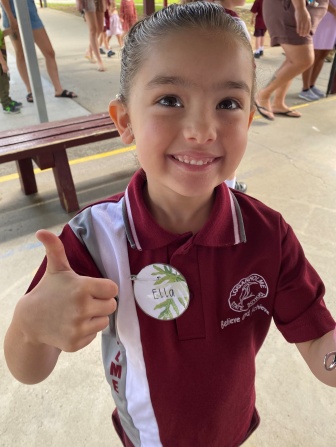At only 6, Ella Hawke has started Year 1 this year with speech and language skills on par with her peers.
With profound deafness in her right ear and mild hearing loss in the left, Ella’s ability to hear, listen and speak so clearly is thanks to a cochlear implant, but also to regular audiology and specialist speech therapy sessions at NDIS provider Hear and Say, funded through Ella’s NDIS plan.
Ella is already a whiz at teaching others about the remarkable technology that allows her to hear.
“Hello, I’m going to tell you about magic ears,” she says, facing a camera and addressing her imagined audience with a charismatic confidence.
“They can help you hear and if you put them off at night, they don’t hurt.
“So, they have a magnet bit and you have to go to a hospital and get a magnet in your head …so, I went to the hospital and I got it.”
Ella has a cochlear implant with an external sound processor, which she calls her magic ear.
“So, here’s my magic ear on the back here and they’re not that bad – you can put stickers and things on it too,” she says, turning to her side to display the processor.
“And you can put a butterfly on the stuff too, you can put butterfly things on it.”
Queensland NDIS provider Hear and Say supports Ella with early approach therapies, while NDIS Partner in the Community, the Benevolent Society, helps Ella and her family to manage her plan.
“It was a great relief to have that support – they have both been amazing,” says Stephanie Hawke, Ella’s mum.
“Ella’s NDIS support has taken a lot of the stress and pressure off. We’ve been able to access speech, occupational and audiology therapies and more recently some social work, to help with her confidence.
“Ella was about nine-months’ speech delayed and she’s now caught up to her peers, so her speech is actually age-appropriate. We’re so proud of her, it’s definitely been worth all the weekly and fortnightly appointments, and all the time and effort.”
Ella’s close connection with technology extends to her new classroom at Loganholme State School, where she started Prep a few weeks ago.
For Ella, crowded, noisy classrooms can be stressful and make it difficult to hear properly, even with her magic ear. So, she carries an additional piece of technology to school every day, known as a Mini Mic – a tiny blue-tooth microphone, which her teachers wear.
It means Ella can hear her teachers clearly, even in a busy classroom.
“The Mini-Mic is having a massive impact for Ella, without that, it makes things pretty difficult for her in a classroom,” says Stephanie.
“When Ella arrives at school every day, the first thing her teachers do is connect her mic. The school has been incredible, they have made every effort to make things easier for her.”
Ella also uses another piece of assistive technology because, as she explains in her video, her magic ear is “definitely not waterproof…the power can come out and then I can’t hear.”
A silicon sleeve and water-proof coil, known as Aqua+, funded through her NDIS plan, protects Ella’s processor in water. For Ella, learning to swim is vital.
“Because of the reason for Ella’s hearing condition, enlarged vestibular aqueduct syndrome, she suffers vertigo and changes of pressure under water,” says Stephanie.
“Even as an adult, she’s not allowed to swim alone in case she gets knocked under water, which is why the swim lessons are so important. It’s for her safety so she doesn’t panic if she falls into water.”
Not only is she a budding film-maker, she’s also a passionate animal lover with her sights firmly set on a career with animals.
“Ella just loves animals,” says Stephanie. “She says she’s going to work at Australia Zoo in the animal hospital when she grows up and I think she probably will.”



